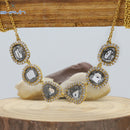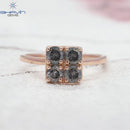Color
Diamonds come in a variety of colors, some of them highly prized (pinks, blues, even yellow). However in a white diamond, the presence of a yellow tint will lower the price of a diamond. The less body color in a white diamond, the more true color it will reflect, and thus the greater its value.
Every Lumera Diamond has been assigned a color grade by the GIA in a viewing environment specially designed to eliminate color from surrounding surfaces as well as the light source itself. This allows the color of the diamond to be accurately measured. Minor differences in diamond color detected in this environment are very difficult if not impossible to detect in a normal environment. The diamond industry has adopted the GIA diamond color scale; almost every diamond sold today is rated using the GIA color scale, whether it was actually certified by the GIA or not.
The GIA grades diamonds on a scale of D (colorless) through Z (light color). All D-Z diamonds are considered white, even though they contain varying degrees of color. True fancy colored diamonds (such as yellows, pinks, and blues) are graded on a separate color scale.
GIA GRADE COLOR SCALE

The photo shows a master set used by gemologists to grade color in diamonds. Each diamond to be graded is compared to the master set to determine where it should fall on the diamond color scale. The colors you see below are slightly exaggerated, since viewing diamonds face down makes their body color more pronounced. The face down orientation makes the detection of body color easier because brightness and fire are minimized when the diamond is face down.
The vast majority of untrained observers (and many gemologists) cannot distinguish a color grade from the one just above or below unless the diamonds are compared side by side in a controlled environment.
Color becomes more important as carat weight increases, because color is easier to perceive in a larger diamond, just as a carafe of white wine shows more color than a single glass.
HOW ARE FANCY COLORS GRADED?
Fancy Color begins beyond the grade Z in the color grading scale. (shown above) While colorless, near colorless, faint and light diamond colors are graded from the face-down position. Laboratory graders assess fancy color diamonds from the face-up or top view of the diamond.
Graders evaluate the hue, tone, and saturation of each diamond.
Hue - Graders evaluate the hue, tone, and saturation of each diamond.
Tone - A diamond's lightness or darkness in relation to body color
Saturation - The intensity or degree of color
FANCY COLOR TERMS ON GRADING REPORTS
Fancy color diamonds are graded using the following terms:
Fancy color diamond grading is a complex process, and colors are evaluated based on the intensity. Generally, the more rich and saturated the color, the higher the value. Fancy color diamonds that are true to hue with vivid coloration will be priced higher than lighter and less saturated stones.

WHAT CAUSES COLOR IN DIAMONDS?
Trace elements, structural irregularities, and radiation generally cause fancy diamond color. Here is a breakdown of common causes of natural fancy diamond color.
Yellow Diamond - Presence of nitrogen
Brown, Pink, and Red Diamonds - Colored graining, which results from structural irregularities in the crystal lattice--sometimes in combination with an impurity.
Blue Diamonds - Presence of boron with possible presence of hydrogen.
Green Diamonds - Natural radiation
Grey and Violet Diamonds - Most likely the presence of hydrogen (grey diamonds are known for high amounts of hydrogen, while violet diamonds are still being studied for exact cause of color)
Black Diamonds - Dark inclusions or impurities, which are great in number and evenly distributed throughout a diamond
Orange Diamonds - Structural irregularities in combination with the presence of trace elements like nitrogen, though exact cause of color is still being studied.




